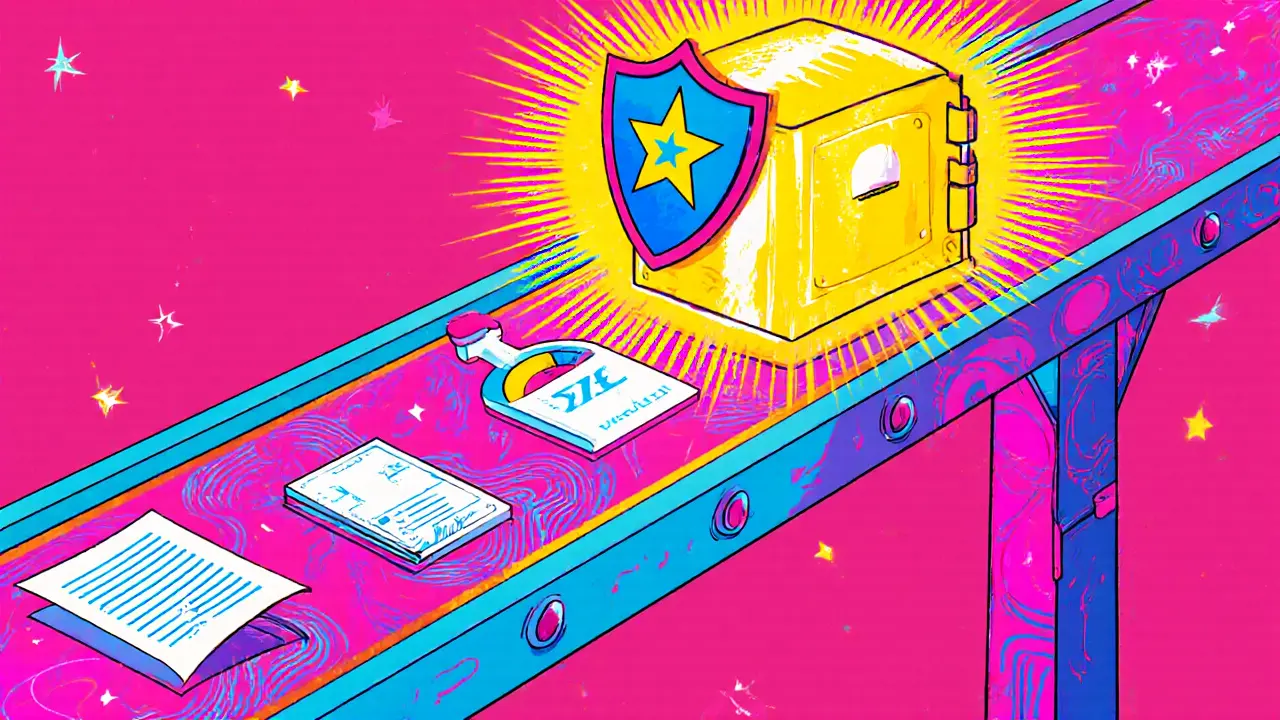Under-Collateralized Loan Risk Calculator
Loan Calculator
Compare traditional over-collateralized lending with emerging under-collateralized DeFi lending models. Input your loan parameters to see required collateral and risk assessment.
Higher score indicates better creditworthiness (based on reputation systems, on-chain history, etc.)
Over-Collateralized Model
Typically requires 125-200% collateral for loan security.
Minimum collateral required: $0
Under-Collateralized Model
Uses reputation systems, credit score oracles, and insurance pools to assess risk.
Approximate collateral required: $0
Risk Assessment:
Under-collateralized DeFi Loans are emerging as the next big wave in decentralized finance lending that reduces or removes the need for borrowers to lock up huge amounts of crypto as security. Today most platforms still demand 125‑200% over‑collateral, which locks out anyone without a sizeable crypto stash. This article breaks down why the market is shifting, what tech is making it possible, and how the ecosystem might look in the next few years.
Why the Over‑Collateralized Model Falls Short
Over‑collateralization was a clever safety net when DeFi was young. By requiring, say, $150 of ETH to borrow $100 of USDC, protocols like Aave could guarantee solvency without a credit bureau. The trade‑off? Only users who already own large crypto balances can tap the system. That runs counter to DeFi’s promise of financial inclusion.
Compare this with the U.S. unsecured personal loan market, which topped $178 billion in Q1 2022-far larger than the total value locked in DeFi lending. Traditional banks serve millions who have no collateral at all, using credit scores and income verification. DeFi, by contrast, keeps most of that potential demand locked out.
What Under‑Collateralized DeFi Lending Could Unlock
Imagine a borrower in Wellington who needs a few thousand dollars to cover tuition. With a trust‑less protocol that only checks on‑chain reputation and off‑chain data (like employment proof) via secure bridges, the borrower could get a loan in minutes-no crypto stash required. That opens DeFi to the under‑banked, boosts total capital flowing into the ecosystem, and creates new yield opportunities for lenders.
From a macro view, unlocking even 10% of the unsecured personal loan market would dwarf the current $25 billion of DeFi loan TVL. The upside is massive, but getting there means solving a hard problem: how to assess credit risk without a central authority.
Key Technologies Paving the Way
The most talked‑about solution is Chainlink DECO. DECO provides cryptographic proofs that off‑chain data (like a credit score or payroll record) is genuine, without revealing the raw data to anyone. Lenders can therefore trust the information while borrowers keep privacy.
Other building blocks include:
- On‑chain credit scoring: algorithms that aggregate a borrower’s transaction history, loan repayment patterns, and reputation scores stored on the blockchain.
- Reputation systems: decentralized identity layers where users earn trust points for timely repayments, similar to e‑bay seller ratings.
- Insurance pools: collective funds that absorb occasional defaults, keeping individual lenders whole.
- Hybrid collateral models: low‑value NFTs or tokenized real‑world assets that supplement the risk model without requiring full over‑collateral.
Each of these pieces can be combined into a modular risk‑assessment stack that still respects DeFi’s trustless ethos.
Comparing Over‑ vs Under‑Collateralized Models
| Feature | Over‑Collateralized | Under‑Collateralized |
|---|---|---|
| Collateral requirement | 125‑200% of loan value | Often 0% or very low (e.g., 10‑30%) |
| Risk assessment | Purely on‑chain collateral value | Off‑chain data + on‑chain reputation + insurance |
| Target borrowers | Crypto holders with large balances | Anyone with internet access, credit‑worthy profile |
| Lender yield | Moderate, tied to utilization rates | Potentially higher due to increased risk premium |
| Regulatory exposure | Lower (no consumer credit) | Higher (consumer protection, KYC considerations) |
Notice how the risk side flips: over‑collateralized loans rely on asset value, while under‑collateralized ones lean on data and insurance. The shift is what makes the future both exciting and challenging.
Current Market Landscape (2025 Snapshot)
As of Q1 2025, DeFi lending holds roughly $50 billion in total value locked, with about $25 billion in active loan contracts across Compound, Aave, and newer players like Morpho. These protocols still demand heavy collateral, but they’re also experimenting with “stablecoin‑only” pools that reduce volatility risk.
Meanwhile, the under‑collateralized DeFi loan sector remains nascent. Pilot projects using DECO proofs have launched on testnets, and a few DAO‑governed insurance funds are underwriting small personal loans in niche communities. The growth rate is hard to measure precisely, but the number of active under‑collateralized loan contracts grew from a handful in 2023 to dozens by mid‑2025-a clear sign of traction.

Regulatory Hurdles and Why They Matter
Consumer‑credit law is one of the biggest unknowns. In the U.S., the Consumer Financial Protection Bureau (CFPB) has hinted that any protocol offering unsecured loans could be classified as a “credit provider,” triggering licensing and disclosure requirements.
European regulators are equally cautious, especially after the 2024 “Crypto Credit Directive” proposals that would demand transparency on default handling and borrower protection. For DeFi projects, navigating these rules means either building compliance layers (KYC, AML) or staying out of regulated jurisdictions-both of which affect accessibility.
Pragmatically, many teams are choosing a hybrid approach: keep the core protocol permissionless, but funnel high‑risk loans through a regulated entity that acts as a “bridge” between the on‑chain world and traditional finance compliance.
Roadmap: What to Expect in the Next 2‑3 Years
- Standardized credit‑score oracles: Expect at least three major oracle providers to launch DECO‑backed credit‑score feeds, making risk data plug‑and‑play for developers.
- Insurance-backed lending pools: Decentralized insurance DAOs will start offering coverage for under‑collateralized loans, reducing lender exposure.
- Regulatory sandboxes: Jurisdictions like Singapore and Switzerland will host sandbox programs where DeFi lenders can test compliant under‑collateralized products.
- Hybrid loan products: Platforms will blend a small on‑chain collateral (e.g., 10% of loan) with off‑chain credit checks, smoothing the transition for users and regulators.
- Mass‑adoption use cases: Think payroll‑linked loans, tuition financing, and small‑business credit-all delivered via smart contracts that settle instantly once conditions are met.
If these milestones hit, the DeFi lending landscape could look dramatically different by 2027: a multi‑billion‑dollar under‑collateralized market co‑existing with traditional over‑collateralized pools.
Practical Tips for Early Adopters
If you’re a developer wanting to experiment, start with a testnet version of DECO and build a simple loan contract that pulls a credit‑score oracle. Keep the loan size tiny (under $1,000) and use a community‑run insurance pool to cover defaults.
Lenders should diversify across both over‑ and under‑collateralized pools. The higher yields on under‑collateralized loans can boost returns, but the risk profile is very different-treat them like venture capital investments.
Borrowers interested in the new products should watch for DAO‑governed “credit circles” that operate on reputation. Joining a credit circle early can boost your on‑chain reputation score, unlocking better rates later.
Conclusion: The Pace of Change Is Accelerating
Under‑collateralized DeFi loans aren’t a distant fantasy-they’re already being prototyped, funded, and tested. The biggest barrier is not technology; it’s finding the right blend of risk assessment, insurance, and regulatory compliance that keeps the system trustless while letting borrowers without crypto assets participate.
For anyone watching DeFi’s evolution, the next few years will be the litmus test: can the sector keep its promise of open finance while scaling to serve the billions who need credit today? If the answer is yes, we’ll see a seismic shift in how capital flows across the blockchain.

What exactly is an under‑collateralized DeFi loan?
It is a loan issued through a decentralized protocol where the borrower does not need to lock up assets equal to or greater than the loan amount. Risk is managed instead through credit‑score oracles, reputation systems, or insurance pools.
How does Chainlink DECO help under‑collateralized lending?
DECO creates cryptographic proofs that off‑chain data-like a traditional credit score-is authentic without exposing the raw data. Smart contracts can then trust that data for risk decisions.
Are there any live under‑collateralized DeFi loan platforms?
As of late 2025, most projects are in pilot or testnet phases. A few DAOs have launched small‑scale lending pools on Polygon and Arbitrum, but mainstream usage is still emerging.
What risks do lenders face with under‑collateralized loans?
Higher default risk, reliance on off‑chain data that could be spoofed, and potential regulatory crackdowns. Insurance pools and diversified exposure can mitigate these risks.
Will regulators ban under‑collateralized DeFi lending?
It’s unlikely to be outright banned; instead, regulators will push for compliance layers-KYC, AML, and consumer‑protection rules-especially for protocols that attract retail borrowers.

Write a comment